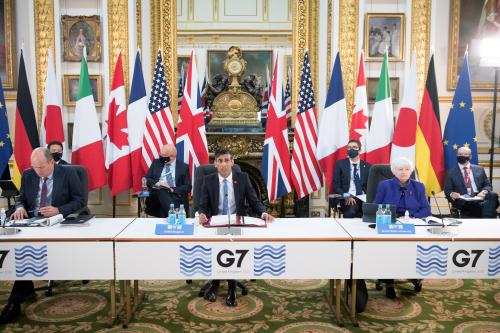This piece is based on remarks by the author at a trans-Atlantic dialogue on the future of NATO after Afghanistan hosted by Atlantik-Brücke.
As U.S. President Joe Biden continues his Europe tour, seeking to rally the leading democracies, a looming question is the future role of NATO. As the alliance contemplates the conclusion to its 20-year operation in Afghanistan, it confronts serious questions about its roles and relevance from political camps on both sides of the Atlantic.
The starting point for the alliance must be to recognize that it leaves Afghanistan in a world entirely transformed from when it entered. NATO started operations in Afghanistan at the height of American unipolarity, at the peak of the Western dominance of the international system. It leaves at a moment when the West is constrained internally and challenged externally, including by authoritarian powers of growing capacity — and perhaps growing coordination.
FOUR REGIONS
To chart its future role in this world, NATO needs to start by addressing the core question of its geographical scope.
It should start in Europe. NATO was born as an instrument to protect Europe and the democratic West from a threat from Moscow. Its first task in 2021 and beyond must be to protect Europe and the democratic West from a threat from Moscow. That threat is nowhere near as severe as it was during the Cold War and it is of very different character, but it is a threat nonetheless and a complex one, involving gray operations like the Skripal attack, political interference, and nuclear saber-rattling. It would be the height of irony if in seeking to respond to China or other new challenges, NATO failed to mount an adequate response to Russia. Not all the instruments to respond to Russia are in NATO’s hands; many of them reside with the European Union. But that is a bureaucratic and institutional distinction that can be overcome; the broader point is that Europe working with the United States must restore a sense of collective defense against Moscow’s efforts to weaken the West. NATO has a vital role in that.
Coordination on Russia policy was extraordinarily difficult during the Trump administration; it must now be central to U.S.-Germany, U.S.-U.K., and U.S.-EU/NATO dialogues. That includes the contentious issue of Ukraine’s future Euro-Atlantic integration.
But the geopolitical challenge to the democratic West doesn’t end in Europe. The second vital region is Asia. That is of course essentially a China question, and that in turn is an economic, technological, values, and military question. Whether or not NATO has an institutional role in Asia remains to be determined, though Secretary General Jens Stoltenberg has argued that NATO’s new strategic concept must address the challenge that both Russia and China pose to a rules-based order. As we see key NATO members like Britain and France increasing their maritime presence in the Indo-Pacific, it’s a central question for the alliance’s future. Put this starkly: If the United States views China as its core strategic challenge and NATO is its most important alliance, what happens to NATO if there’s no match between those two? NATO has to find a way to add value, whether by contributing to U.S.-led crisis management planning in Asia, or through a focus on technological and economic resilience — ideally, both. That includes a focus — in close coordination with the EU — on China’s economic statecraft and political influence in Europe itself.
Third, NATO will have to address whether it has a continuing role in Central Asia or the Middle East. Whereas NATO’s rise to an Article 5 defense of the United States after the September 11 attacks was an extraordinarily important political act, NATO’s operational performance in the wider Middle East has been mixed. That’s in large part because NATO lacks a dynamic, effective political mechanism through which to lead its in-country engagements; it is military-led, not multi-dimensional. (There have of course also been challenges at the operational level.) The wider history of civil war management and counterterrorism response tells us that closely integrated political, military, and development strategy is what’s required. Those are not NATO’s strengths.
A fourth region that should be on NATO’s agenda is the Arctic. We have now firmly passed the point where the Arctic is primarily a question of climate change, commerce, and scientific cooperation. All those continue, but the Arctic is now also a zone of military pre-positioning and tension. As Russia beefs up its air and naval presence in Murmansk and beyond and China begins to tiptoe into a wider “dual-use” presence, NATO has useful assets and the critical geography to bring to bear, especially those countries on NATO’s northern flank, like Norway, Canada, and the U.K. (as well as the U.S. of course).
FOUR ISSUES
In tackling the issues of those geographical regions, NATO also needs to confront challenges of coherence and capacity. Two decades of focus on counterterrorism and stabilization efforts in Afghanistan have not left NATO well-equipped, well-trained, or well-postured to confront new dynamics of great power rivalry. NATO needs to reorient and retool itself.
First, with regards to technology. NATO has become the most advanced international mechanism for responding to cyberattacks. That’s important and should be sustained, but to confront future challenges the alliance has to go deeper on questions of artificial intelligence (AI) and its application to the military domain. Not all members of NATO will bring much to this table; but a core group of countries — including smaller members with niche capabilities — could work with the U.S. to develop critical AI-infused deterrent capacity.
Second is interoperability. NATO developed in important ways its engagement with non-NATO members in Afghanistan, notably Australia, the Gulf Arab states, Singapore, and South Korea. And it’s also had some limited experience in interoperability with countries like India in the Shared Awareness and De-confliction (SHADE) counterpiracy operations off the Somali coast. But whether or not it can have a sustained mechanism for interoperability with non-NATO members, especially Asian powers, in the absence of a major operational action like Afghanistan is a challenge, one that’s central to its future.
Third, is the looming internal question — i.e. Turkey and Hungary. These cases are primarily portrayed in terms of the erosion of democracy, and that’s a real question to be sure; but NATO has had non-democracies or weak democracies in its ranks before. Weak democracy is one thing, buying Russian weapon systems or otherwise supporting Russian – or Chinese – strategy, is rather another. NATO needs to be resolute that behavior that strengthens Russia’s hand in Europe (or elsewhere) will come at a steep cost — as French President Emmanuel Macron recently hinted.
Last, but perhaps most importantly, NATO members will ultimately have to grapple with the question of European strategic autonomy. Asked the other way around, they have to address the issue of U.S. reliability. Here, it’s worth highlighting that NATO came through the Trump experience far less scarred than many other multilateral arrangements; the alliance has deep support in the U.S. defense establishment and in Congress. Still, the issue looms over the question of NATO’s future.
In my view, it’s the wrong way to ask the question. The right way is: If we start seeing genuine collaboration between China and Russia to challenge the West, is NATO capable of responding? Can NATO mount two strategic operations at the same time, say in response to an acute U.S.-China crisis in the western Pacific and a simultaneous Russian move on a sliver of the Baltics? The first might be U.S.-led, but usefully buttressed by European naval and economic assets, and the second could be Europe-led, but reassured and buttressed by the United States, including in terms of nuclear posture. That is not currently the concept nor the premise for command and control arrangements, but it’s well within the capability of NATO members to produce such an arrangement.
A NATO capable of responding in those terms would be a NATO fit for the strategic challenge in front of us.








Commentary
The future of NATO in an order transformed
June 14, 2021